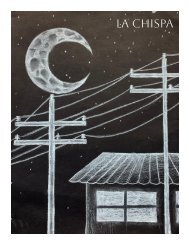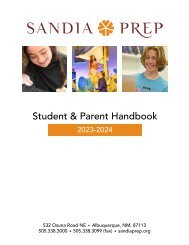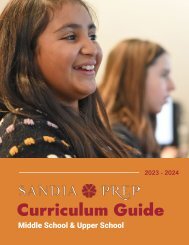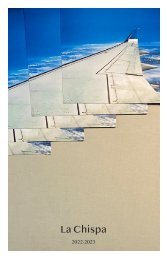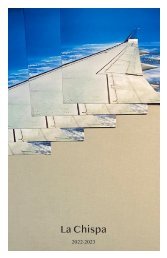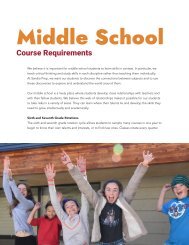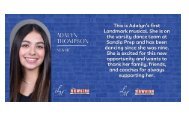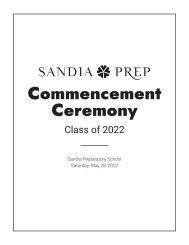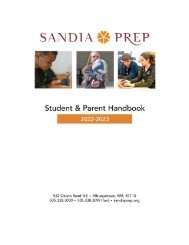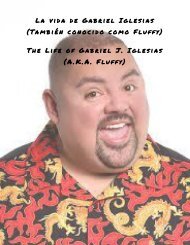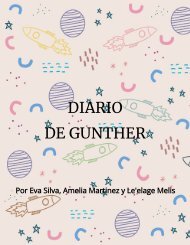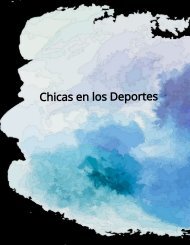Sandia Prep Curriculum Guide 2018 - 2019
Middle School and Upper School curriculum guide for the 2018 - 2019 school year
Middle School and Upper School curriculum guide for the 2018 - 2019 school year
Create successful ePaper yourself
Turn your PDF publications into a flip-book with our unique Google optimized e-Paper software.
SCIENCE<br />
<strong>Sandia</strong> <strong>Prep</strong> endeavors to introduce<br />
students, through comprehensive course<br />
work, to the many facets of science. In<br />
both middle and upper school, science<br />
classes are taught using tradition principles<br />
coupled with innovation and questionbased<br />
thinking to prepare students to be<br />
leaders in the 21st century.<br />
In middle school, students begin their<br />
journey gathering a fundamental<br />
understanding of what science is<br />
through the exploration of physical,<br />
life, and Earth science. This foundation<br />
emphasizes scientific theory and proper<br />
lab techniques, as well as providing them<br />
with hands-on experience through data<br />
collection and analysis. Upper school<br />
students are excited about moving<br />
into specific areas of science, starting<br />
with geology in 9th grade, where they<br />
are provided a window into the past<br />
through the vast geology of New Mexico.<br />
Biology students study genetics, bacteria,<br />
microscopy, photosynthesis, respiration,<br />
and ecosystems. They are lead through a<br />
variety of complex labs in chemistry class.<br />
The physics curriculum allows students<br />
the opportunity to not only learn how<br />
something works, but physically apply<br />
the theories that are studied in lecture. By<br />
graduation, students are equipped to be<br />
competitive in any science program at any<br />
university.<br />
19<br />
Science 6 - General Lab Science<br />
In this lab based foundation class, students<br />
study a wide variety of topics in various<br />
disciplines of science. Using examples<br />
of work done by real-world scientists,<br />
students model, question, interpret,<br />
and analyze data sets and experiments<br />
throughout the year. Practicing proper<br />
lab techniques and scientific methods,<br />
students acquire new laboratory skills and<br />
increase confidence in their understanding<br />
of science concepts, both locally and<br />
globally. Projects include LEAP (Learning<br />
the Ecosystems of Albuquerque Project),<br />
which requires students to research a<br />
specific species, its ecosystem, and how<br />
environmental factors can affect things<br />
such as behavior and migration; and<br />
involvement in national and international<br />
oceanic research project, which allows<br />
students to work on current research<br />
being conducted by international research<br />
teams. At the end of the sixth grade year,<br />
students have a strong foundation of skills<br />
and content knowledge necessary for the<br />
advanced science courses in upper school.<br />
Science 7 - Life Science<br />
The primary objective of the 7th grade<br />
science program is for students to explore<br />
biological communities and the roles of<br />
living organisms. The class begins in the<br />
school garden, with inquiry-driven field<br />
ecology experiments on plants, pollinators,<br />
ants, or soil. Students delve into botany by<br />
germinating seeds, studying plant growth<br />
and plant anatomy. With this foundation<br />
students transition into ecosystem studies<br />
of diverse microscopic pond life and the<br />
intricate structures inside cells. The class



